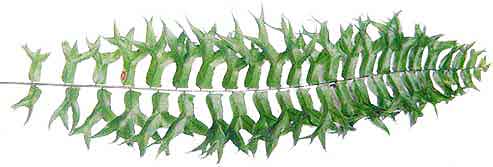| Botany
Fishtail fern is a stoloniferous fern with short erect
rhizomes. Leaves are up to 90 centimeters long, leathery, arching, green to yellow
green, with the leaflets forked at the end.
Distribution
Widely cultivated in Philippine gardens.

Constituents
- In a study for nutritive value, leaves showed to contain more (P<0,05) dry matter and crude protein than any other portion of the plant. Stem contains more crude fiber and ash than the leaves. (5)
- Phytochemical screening of essential oil, methanol extract and fractions yielded anthraquinones, alkaloids, tannins, steroids, phytosterol, saponin, triterpenoids and flavonoids.
Essential oil, methanol extract and methanol fractions were rich in phenolic and flavonoid contents. GCMS analysis yielded various biologically important compounds; dominant compounds were benzeneacetaldehyde, alpha-cubebene, butyrolactone, phenol, benzyl alcohol, phenol, 2-methoxy-, 4h-pyran-4-one, 2,3-dihydro- 3,5-dihydroxy-6-methyl, 2h-pyran-2-one, 4,6-dimethyl-, catechol, benzofuran, 2,3-dihydro-, phenol, 2,4-bis(1,1-dimethylethyl), hexadecanoic acid, methyl ester, n-hexadecanoic acid, 9,12-octadecadienoic acid, methyl ester, phytol, gamolenic acid and octadecanoic acid. (7)
-
Phytochemical screening of aqueous, chloroformic and ethanolic extracts yielded sterols, polyterpenes, tannins, polyphenols, flavonoids, quinones, and saponins. (see study below) (9)
- Study of phytochemical content yielded TP (total phenolics) of 59.37 ± 0.55 mg GAE/g, THC (total hydroxycinnamic acid) of 55.67 ± 0.36 mg CAE/g, TF (total flavonoids) of 184.85 ± 1.51 mg QE/g, and TPro (total proanthocyanidins) 9.97 ± 0.55 mg LE/g. (see study below) (10)
- Phytochemical analysis of aqueous and ethanolic leaf extracts yielded the presence of alkaloids, tannins, flavonoids, saponins, phlobatannins, cardiac glycosides, terpenes, anthraquinones. (see study below) (11)
Properties
- Considered antimicrobial, hepatoprotective, antioxidant.
- Studies have shown antioxidant, radical scavenging, anti-inflammatory, antifungal, hepatoprotective, antihypertensive, chemopreventive, cytotoxic, phytoremediative properties.
Parts utilized
Leaves, roots.
Uses
Nutrition / Edibility
- Leaves are boiled and eaten
as vegetable.
- In west New Guinea, flour is reported to be extracted from the roots by pounding it into flour. (1)
- Rhizomes and young shoots eaten as vegetable.
Folkloric
- No recorded folkloric use
in the Philippines.
- In Malaysia, used for skin disorders.
- In Tahiti, used for blisters,
boils, abscesses and sores. (4)
- Used to treat malaria.
- In Cameroon, decoction of fronds used for lower abdominal pains.
- In NW Guyana, leaves used for treatment of
wounds and cuts. (2)
- The Ehotile people of eastern littoral of Cote d'Ivoire use the plant for dysmenorrhea and to remove splinters. (13)
Others
- Fodder: Nutritive analysis suggests a potential fodder for dry season feed of small ruminants. (5)
Studies
• Antibacterial / Antifungal: Study investigated the antimicrobial properties of three selected ferns, viz., P. nudum, Nephrolepis biserrata and N. cordifolia. Water and ethanol fractions of fronds were active against most of the tested bacteria and fungal strains. N. biserrata was most inhibitory to E. coli. Phytochemical testing showed the presence of metabolites such as flavonoids, tannins, alkaloids, reducing sugars, triterpenoids, and steroids in all three pteridophytes. (3)
• Hepatoprotective / Antioxidant: Study investigated the protective effect of the methanol extract of N. biserrata leaves against carbon tetrachloride (CCl4)-induced hepatic damage in rats. Results showed high total phenolic content which may be the major contributor to its strong antioxidant activities. There was also hepatoprotective activity against CCl4-hepatotoxicity. (6)
• Antihypertensive / Leaves: Study evaluated the hypotensive activity of Nephrolepis biserrata leaves in the treatment or prevention of arterial hypertension using a toad aorta model. NB leaf extract provoked the decrease of contraction of the toad aorta induced by epinephrine in the presence and absence of endothelium. The antihypertensive effect may be due to the presence of polyphenols, alkaloid, and terpenes. (see constituents above) (8)
• Antioxidative / Chemopreventive / CCl4-Induced Hepatic Dysfunction / Leaves: Study evaluated the protective effects of methanolic extract of N. biserrata leaves against carbon tetrachloride (CCl4) induced hepatic damage in Sprague Dawley rats. Results showed high phenolic content (127.28 ±1.57 mg GAE/g), which may contribute to its strong antioxidant activity. Histologically, NB decreased fatty degeneration and necrosis in CCl4 administered rats. Results showed strong antioxidant activities and significant hepatoprotection against CCl4 induced toxicity in rats. (9)
• Cytotoxicity: Study evaluated five selected edible and medicinal ferns for cytotoxic activities, viz., Blechnum orientale, Davallia denticulata, Diplazium esculentum, Nephrolepis biserrata, and Pteris vittata. Cytotoxicity was evaluated using methylthiazol tetrazolium assay on chronic myelogenous leukemia cell line (K562). All the fern extracts, except for D. denticulata, showed dose-dependent cytotoxicity against K562 cells. (10)
• Anti-Inflammatory / Leaves: Study evaluated leaf extract of N. biserrata for anti-inflammatory activity on albino wistar mice in inflammatory models induced by xylene and egg white albumen. Treatment with extract showed significant (p<0.05) dose dependent decrease in ear weight in both aqueous and ethanolic extracts. LD50 was 3741.66 mg/kg taken orally. (see constituents above) (11)
• Radical Scavenging and FRP Activities / Leaves: Study of leaves of N. biserrata for radical scavenging activity showed moderate TPC (total phenolic content) with IC50 of 0.53 ± 0.05 mg/ml and AEAC (ascorbic acid equivalent antioxidant) of 740 ± 71 AA/100 g and FRP (ferric ion reducing power) of 422 ± 46 mg/GAE/100g. (12)
• Potential Phytoremediator of Heavy Metal: Study assessed the antioxidant response of N. biserrata growing under metal stress in industrial land heavily contaminated with zinc, followed by lead and copper. Results showed N. biserrata is a moderate accumulator for the tested metals with a bioaccumulation factor between 0 to 0.1. HPLC analysis showed higher levels of myricetin and kaempferol in plant samples from contaminated area. Results showed potential as a potential metal phytoremediator with its capacity to scavenge oxygen radicals when exposed to heavy metal stress. (14)
Availability
- Garden cultivation.
- Plants in the cybermarket.
|






